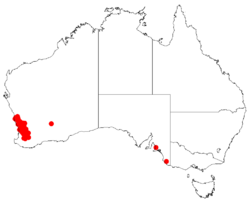Biology:Isopogon dubius
| Pincushion coneflower | |
|---|---|

| |
| Isopogon dubius in the Dryandra Woodland | |
| Scientific classification | |
| Kingdom: | Plantae |
| Clade: | Tracheophytes |
| Clade: | Angiosperms |
| Clade: | Eudicots |
| Order: | Proteales |
| Family: | Proteaceae |
| Genus: | Isopogon |
| Species: | I. dubius
|
| Binomial name | |
| Isopogon dubius | |

| |
| Occurrence data from Australasian Virtual Herbarium | |
| Synonyms[1] | |
| |
Isopogon dubius, commonly known as pincushion coneflower,[2] is a species of plant in the family Proteaceae and is endemic to the south-west of Western Australia. It is a shrub with sharply-pointed, deeply lobed or pinnate leaves and more or less spherical heads of pink to reddish pink flowers.
Description
Isopogon dubius is a shrub that typically grows to a height of 0.5–1.5 m (1 ft 8 in–4 ft 11 in) and has hairy reddish brown branchlets, the young branchlets and young leaves hairy. The leaves are deeply 3-lobed or pinnate, 25–55 mm (0.98–2.17 in) long on a petiole about 20 mm (0.79 in) long, the tips of the lobes, or of the leaflets, sharply-pointed. The flowers are arranged in sessile, more or less spherical heads 40–50 mm (1.6–2.0 in) in diameter with many hairy, egg-shaped involucral bracts at the base. The flowers are 25–30 mm (0.98–1.18 in) long, pink to reddish pink and glabrous. Flowering occurs from July to September and the fruit is a hairy nut, fused with others in hemispherical head up to 30 mm (1.2 in) in diameter.[2][3][4]
Taxonomy
Pincushion coneflower was first formally described in 1830 by Robert Brown who gave it the name Petrophile dubia in the Supplementum to his Prodromus Florae Novae Hollandiae et Insulae Van Diemen from specimens collected in 1827 near the Swan River, by Charles Fraser.[5][6] In 1917 George Claridge Druce changed the name to Isopogon dubius in The Botanical Exchange Club and Society of the British Isles Report for 1916.[7][8]
Distribution and habitat
Isopogon dubius grows in woodland and heath, mainly on the Darling Range from near Wongan Hills to Narrogin in the Avon Wheatbelt, Geraldton Sandplains, Jarrah Forest and Swan Coastal Plain in the south-west of Western Australia.[2][3]
Conservation status
This isopogon is classified as "not threatened" by the Government of Western Australia Department of Parks and Wildlife.[2]
Use in horticulture
Isopogon dubius was first cultivated in Europe in the 1800s. It prefers dry summers and excellent drainage and will tolerate moderate frosts. Full sun is required for the best flower display, although the plant can be grown in partial shade.[4]
References
- ↑ 1.0 1.1 "Isopogon dubius". Australian Plant Census. https://biodiversity.org.au/nsl/services/apc-format/display/84273.
- ↑ 2.0 2.1 2.2 2.3 "Isopogon dubius". FloraBase. Western Australian Government Department of Parks and Wildlife. https://florabase.dpaw.wa.gov.au/browse/profile/2229.
- ↑ 3.0 3.1 Foreman, David B.. "Isopogon dubius". Australian Biological Resources Study, Department of Agriculture, Water and the Environment: Canberra. https://profiles.ala.org.au/opus/foa/profile/Isopogon%20dubius.
- ↑ 4.0 4.1 "Isopogon dubius". Australian Native Plants Society (Australia). http://anpsa.org.au/i-dub.html.
- ↑ "Petrophile dubia". APNI. https://id.biodiversity.org.au/instance/apni/464387.
- ↑ Brown, Robert (1830). Supplementum primum prodromi florae Novae Hollandiae. London. p. 7. https://www.biodiversitylibrary.org/item/77294#page/521/mode/1up. Retrieved 22 November 2020.
- ↑ "Isopogon dubius". Australian Plant Name Index. https://id.biodiversity.org.au/instance/apni/502303.
- ↑ Druce, George C. (1917). "Nomenclatorial Notes: chiefly African and Australian". The Botanical Exchange Club and Society of the British Isles Report for 1916, Suppl. 2 Supplement 2: 629. https://www.biodiversitylibrary.org/page/49460228#page/701/mode/1up. Retrieved 23 November 2020.
Wikidata ☰ Q6086239 entry
 |


